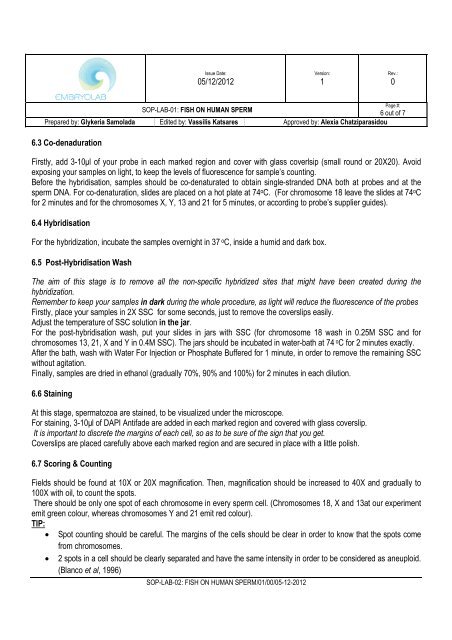WORKSHOP BOOK Fluorescent in Situ Hybridisation - FISH - on Human Sperm
You also want an ePaper? Increase the reach of your titles
YUMPU automatically turns print PDFs into web optimized ePapers that Google loves.
Issue Date:<br />
05/12/2012<br />
Versi<strong>on</strong>:<br />
1<br />
Rev.:<br />
0<br />
SOP-LAB-01: <str<strong>on</strong>g>FISH</str<strong>on</strong>g> ON HUMAN SPERM<br />
Page #:<br />
6 out of 7<br />
Prepared by: Glykeria Samolada Edited by: Vassilis Katsares Approved by: Alexia Chatziparasidou<br />
6.3 Co-denadurati<strong>on</strong><br />
Firstly, add 3-10µl of your probe <str<strong>on</strong>g>in</str<strong>on</strong>g> each marked regi<strong>on</strong> and cover with glass coverlsip (small round or 20X20). Avoid<br />
expos<str<strong>on</strong>g>in</str<strong>on</strong>g>g your samples <strong>on</strong> light, to keep the levels of fluorescence for sample’s count<str<strong>on</strong>g>in</str<strong>on</strong>g>g.<br />
Before the hybridisati<strong>on</strong>, samples should be co-denaturated to obta<str<strong>on</strong>g>in</str<strong>on</strong>g> s<str<strong>on</strong>g>in</str<strong>on</strong>g>gle-stranded DNA both at probes and at the<br />
sperm DNA. For co-denaturati<strong>on</strong>, slides are placed <strong>on</strong> a hot plate at 74 o C. (For chromosome 18 leave the slides at 74 o C<br />
for 2 m<str<strong>on</strong>g>in</str<strong>on</strong>g>utes and for the chromosomes X, Y, 13 and 21 for 5 m<str<strong>on</strong>g>in</str<strong>on</strong>g>utes, or accord<str<strong>on</strong>g>in</str<strong>on</strong>g>g to probe’s supplier guides).<br />
6.4 <str<strong>on</strong>g>Hybridisati<strong>on</strong></str<strong>on</strong>g><br />
For the hybridizati<strong>on</strong>, <str<strong>on</strong>g>in</str<strong>on</strong>g>cubate the samples overnight <str<strong>on</strong>g>in</str<strong>on</strong>g> 37 o C, <str<strong>on</strong>g>in</str<strong>on</strong>g>side a humid and dark box.<br />
6.5 Post-<str<strong>on</strong>g>Hybridisati<strong>on</strong></str<strong>on</strong>g> Wash<br />
The aim of this stage is to remove all the n<strong>on</strong>-specific hybridized sites that might have been created dur<str<strong>on</strong>g>in</str<strong>on</strong>g>g the<br />
hybridizati<strong>on</strong>.<br />
Remember to keep your samples <str<strong>on</strong>g>in</str<strong>on</strong>g> dark dur<str<strong>on</strong>g>in</str<strong>on</strong>g>g the whole procedure, as light will reduce the fluorescence of the probes<br />
Firstly, place your samples <str<strong>on</strong>g>in</str<strong>on</strong>g> 2X SSC for some sec<strong>on</strong>ds, just to remove the coverslips easily.<br />
Adjust the temperature of SSC soluti<strong>on</strong> <str<strong>on</strong>g>in</str<strong>on</strong>g> the jar.<br />
For the post-hybridisati<strong>on</strong> wash, put your slides <str<strong>on</strong>g>in</str<strong>on</strong>g> jars with SSC (for chromosome 18 wash <str<strong>on</strong>g>in</str<strong>on</strong>g> 0.25M SSC and for<br />
chromosomes 13, 21, X and Y <str<strong>on</strong>g>in</str<strong>on</strong>g> 0.4M SSC). The jars should be <str<strong>on</strong>g>in</str<strong>on</strong>g>cubated <str<strong>on</strong>g>in</str<strong>on</strong>g> water-bath at 74 o C for 2 m<str<strong>on</strong>g>in</str<strong>on</strong>g>utes exactly.<br />
After the bath, wash with Water For Injecti<strong>on</strong> or Phosphate Buffered for 1 m<str<strong>on</strong>g>in</str<strong>on</strong>g>ute, <str<strong>on</strong>g>in</str<strong>on</strong>g> order to remove the rema<str<strong>on</strong>g>in</str<strong>on</strong>g><str<strong>on</strong>g>in</str<strong>on</strong>g>g SSC<br />
without agitati<strong>on</strong>.<br />
F<str<strong>on</strong>g>in</str<strong>on</strong>g>ally, samples are dried <str<strong>on</strong>g>in</str<strong>on</strong>g> ethanol (gradually 70%, 90% and 100%) for 2 m<str<strong>on</strong>g>in</str<strong>on</strong>g>utes <str<strong>on</strong>g>in</str<strong>on</strong>g> each diluti<strong>on</strong>.<br />
6.6 Sta<str<strong>on</strong>g>in</str<strong>on</strong>g><str<strong>on</strong>g>in</str<strong>on</strong>g>g<br />
At this stage, spermatozoa are sta<str<strong>on</strong>g>in</str<strong>on</strong>g>ed, to be visualized under the microscope.<br />
For sta<str<strong>on</strong>g>in</str<strong>on</strong>g><str<strong>on</strong>g>in</str<strong>on</strong>g>g, 3-10µl of DAPI Antifade are added <str<strong>on</strong>g>in</str<strong>on</strong>g> each marked regi<strong>on</strong> and covered with glass coverslip.<br />
It is important to discrete the marg<str<strong>on</strong>g>in</str<strong>on</strong>g>s of each cell, so as to be sure of the sign that you get.<br />
Coverslips are placed carefully above each marked regi<strong>on</strong> and are secured <str<strong>on</strong>g>in</str<strong>on</strong>g> place with a little polish.<br />
6.7 Scor<str<strong>on</strong>g>in</str<strong>on</strong>g>g & Count<str<strong>on</strong>g>in</str<strong>on</strong>g>g<br />
Fields should be found at 10X or 20X magnificati<strong>on</strong>. Then, magnificati<strong>on</strong> should be <str<strong>on</strong>g>in</str<strong>on</strong>g>creased to 40X and gradually to<br />
100X with oil, to count the spots.<br />
There should be <strong>on</strong>ly <strong>on</strong>e spot of each chromosome <str<strong>on</strong>g>in</str<strong>on</strong>g> every sperm cell. (Chromosomes 18, X and 13at our experiment<br />
emit green colour, whereas chromosomes Y and 21 emit red colour).<br />
TIP:<br />
• Spot count<str<strong>on</strong>g>in</str<strong>on</strong>g>g should be careful. The marg<str<strong>on</strong>g>in</str<strong>on</strong>g>s of the cells should be clear <str<strong>on</strong>g>in</str<strong>on</strong>g> order to know that the spots come<br />
from chromosomes.<br />
• 2 spots <str<strong>on</strong>g>in</str<strong>on</strong>g> a cell should be clearly separated and have the same <str<strong>on</strong>g>in</str<strong>on</strong>g>tensity <str<strong>on</strong>g>in</str<strong>on</strong>g> order to be c<strong>on</strong>sidered as aneuploid.<br />
(Blanco et al, 1996)<br />
SOP-LAB-02: <str<strong>on</strong>g>FISH</str<strong>on</strong>g> ON HUMAN SPERM/01/00/05-12-2012


